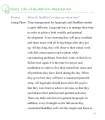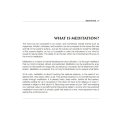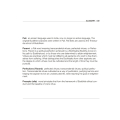spiritual teachings : ค้นหาหนังสือธรรมะ หน้า 4 / 11
หน้าหนังสือทั้งหมด

181
Understanding External and Internal Fools in Buddhism
1) External Fools include non-Buddhists. They are determined to demolish Buddhism, whether they are of other religious affiliations or not. They typically try to cast aspersions upon Buddhist monks. W
In Buddhism, External Fools are non-Buddhists who seek to distort and undermine Buddhist teachings, casting aspersions on monks and creating confusion. Internal Fools, on the other hand, are Buddhists

38
Understanding the Concept of Dhammakāya in Buddhist Thought
D.III.84
Vāsettha and Bhāradvāja, he whose confidence in the
Tathāgata is settled, rooted, established, solid, irremovable by
any ascetic or brahmin, any deva or Māra or Brahmā or anyone
in the world
In this passage, Vāsettha and Bhāradvāja discuss the unwavering confidence in the Tathāgata, stating that those deeply rooted in dhamma can claim to be heirs of dhamma. The term 'dhammakāya' and its i

129
Exploring the Center of the Body in Meditation
Thus, the phrase 『息中具有四大。心在中』 can be interpreted as: "the mind should be located at the centre of the body while breathing (in and out)." The precise position of the centre of the body where the mind
This text examines the phrase 'the mind should be located at the center of the body while breathing in and out.' It references the teachings of PhraMongkolthepmuni regarding the center's location abov

71
Growth of Dhammakaya Foundation's Global Influence
ROM QUALITY GREW QUANTITY
The reputation for training offered by the Dhammakaya Foundation has spread primarily by word of mouth, increasing the popularity of activities held, as the years pass by. P
The Dhammakaya Foundation's dedication to meditation training has led to a significant reputation, expanding through word of mouth and enhancing lives. Local branches in Thailand and abroad facilitate

15
The Lord Buddha's Teachings
The Lord Buddha's Teachings
The Lord Buddha's Teachings
Solve the Root Causes of Life's Problems
Habits, Mind, Body, Word
1. The Lord Buddha's Teachings aim to completely remove defilements from the
The Lord Buddha's Teachings focus on eliminating defilements from the mind to resolve all problems in life. By mastering one's habits, which govern both the body and mind, individuals can achieve cont

28
Understanding the Root Causes of Life's Problems through Buddhism
Summary
Concepts - The root causes of life's problems include economic problems, conflicts, and defilements
- The Lord Buddha's Teachings aim to correct the root causes of life's problems
- Buddhism c
This text discusses the root causes of life's problems, including economic issues, conflicts, and mental defilements, proposing that the Teachings of the Lord Buddha offer comprehensive solutions. By

20
Superior Love through Superior Dhamma
Superior Love
through Superior Dhamma
Because we are human beings, none of us are perfect.
We all come with a baggage of deficiencies. We can
cope with our own deficiencies but we cannot
tolerate some
This text discusses the challenges of living with a partner and how the Dhamma provides guidance for a harmonious family life. It highlights the four virtues: truthfulness, self-control, endurance, an

26
Unbreakable Bonds: The Eternal Connection of Family
Unbreakable Bonds
The bond between a husband and wife can be broken;
but the bond between parents and children is
unbreakable even through death. Even if we do not
know who our parents are (due to cer
The bond between parents and children remains unbreakable even through death. While some may show their love occasionally, expressions of gratitude should be more frequent. The Lord Buddha exemplified

43
Daily Life of Buddhists and Meditation Practices
Daily Life of Buddhists Meditation
Monica
: What do Buddhist's scripts say about time?
Luang Phaw: Time management for laypeople and Buddhist monks
is quite different. Laypeople have to manage their t
In Buddhism, time management differs for laypeople and monks. While both seek spiritual growth, laypeople balance everyday life with meditation, prayers, and mindfulness. Morning routines include pray

204
Journey to Joy
Journey to Joy
204
The degree of patience for where we are in
our spiritual journey is quite remarkable. I have
learned that we can work miracles by realizing the
miracle within ourselves. To transfor
The journey towards joy highlights the importance of patience in our spiritual growth. To create miracles, we must discover the miracle within ourselves. By transforming individually, we contribute po

81
What is Meditation?
WHAT IS MEDITATION?
The mind can be compared to an ocean, and momentary mental events such as happiness, irritation, fantasies, and boredom can be compared to the waves that rise and fall on the ocea
Meditation serves as a means for mental development, allowing individuals to calm the turbulence of the mind and access its inherent clarity. This practice is not limited to any one faith, emphasizing

51
Relinquish All Else: The Path to Dhamma
53. RELINQUISH ALL ELSE
Merely meditating and reciting the mantra "samma arahang" will create merit. It is not easy to attain Dhammanetya when the mind wants to dart here and there around the entire
The text emphasizes the significance of meditating and reciting the mantra 'samma arahang' to create merit. To attain Dhammanetya, one must bring the mind back to focus, specifically above the navel,

52
Glossary of Key Buddhist Terms
1. Arahant
Glossary
An enlightened being who is free from defilements
and no longer subjected to rebirths or has attained
Nibbana.
2. Bodhisatta
One who determines to be a Buddha in the future.
3. Dha
This glossary provides definitions of key terms in Buddhism, including Arahant, an enlightened being who has attained Nibbana, Bodhisatta, a future Buddha, and Dhamma, referring both to ultimate truth

113
Buddhist Meditation and Spiritual Activities
The image contains three pictures, each depicting people involved in religious or spiritual activities, probably in a Buddhist setting. The text content is not visible or is not the primary focus, but
This content showcases three images capturing the essence of Buddhist spiritual practices. The top image features a monk leading meditation on a raised platform, guiding a group seated on mats in a tr

163
Understanding Pali and Parami in Buddhism
Pali: an ancient language used in India, now no longer an active language. The original Buddhist scriptures were written in Pali. Pali texts are used by the Theravada school of Buddhism.
Parami: a Pa
Pali is an ancient language from India that is no longer actively spoken but holds significant historical importance as the original language of Buddhist scriptures. These scriptures serve as a core e

7
Call to the Angels - A Chant for Protection
Call to the Angels
(In Pali)
Samantā cakkavāleṣu
Saddhammam muni-rajassa
Dipe rathe ca gāme
Bhummā cāyantu devā
Tīṭhantā santike yang
Dhammassavanakālo ayambhadantā
Dhammassavanakālo ayambhadantā
Dham
This text serves as a call for the celestial beings (devas) from around the galaxies to gather and listen to the recitation of the True Dhamma, which is believed to lead to spiritual liberation. It em

5
Meditation and Enlightenment
There is no visible textual content in the image to extract with OCR. The image depicts a serene scene of a monk or spiritual teacher sitting cross-legged in front of a decorated figure that appears t
This image captures a moment of tranquility where a monk shares wisdom in front of a decorated figure resembling the Buddha. Several monks-in-training absorb the teachings, reflecting the essence of s

42
Kala, Anathapindika's Son
3
KALA, ANATHAPINDIKA'S SON
This instruction was given by the Teacher while he was in residence at Jetavana with reference to Kala, son of Anathapindika.
Tradition has it that Kala, although the s
This teaching illustrates the challenges faced by Kala, son of the wealthy Anathapindika, who remains indifferent to his father's guidance and the teachings of the Buddha. Despite his father's attempt

5
The Shift in Enlightenment Concept in Prajñāpāramitā Sūtras
As demonstrated, the Prajñāpāramitā Sūtras changed a concept of enlightenment from "adapting a monastic lifestyle and practicing meditation extremely" to "accumulating good karma in daily life." This
The Prajñāpāramitā Sūtras redefined the concept of enlightenment in Buddhism, moving away from the traditional focus on monastic practices and extreme meditation. Instead, it emphasized the importance

36
The Power of Inner Love in Marriage
CERVICE
Testimony 1
Mrs Anchalee Nathanson, USA
"His teachings, above all, instill in us the intellect to
cultivate inner, rather than extrinsic, love. The fully
fledged inner love shall safeguard the
Mrs. Anchalee Nathanson shares her journey of marriage and love influenced by Luang Phaw Dhammajayo's teachings. She emphasizes that true happiness stems from nurturing inner love, which fosters spiri
